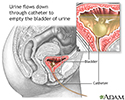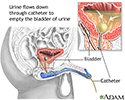Cytology exam of urine
Urine cytology; Bladder cancer - cytology; Urethral cancer - cytology; Renal cancer - cytologyA cytology exam of urine is a test used to detect cancer and other diseases of the urinary tract.
How the Test is Performed
Most often, a clean catch urine sample is collected in your health care provider's office or at home. This is done by urinating into a special cup. The clean-catch method helps prevent germs from the penis or vagina from getting into a urine sample. To collect your urine, you will get a clean-catch kit from your provider. It will contain a cup with a lid and sterile wipes. Follow instructions exactly.
Clean catch urine sample
A clean catch is a method of collecting a urine sample to be tested. The clean-catch urine method is used to prevent germs from the penis or vagina ...

The urine sample can also be collected during cystoscopy. During this procedure, your provider uses a thin, tube-like instrument with a camera on the end to examine the inside of your bladder.
Cystoscopy
Cystoscopy is a surgical procedure. This is done to see the inside of the bladder and urethra using a thin, lighted tube.

The urine sample is sent to a lab and examined under a microscope to look for abnormal cells.
How to Prepare for the Test
No special preparation is needed.
How the Test will Feel
There is no discomfort with a clean catch urine specimen. During cystoscopy, there may be slight discomfort when the scope is passed through the urethra into the bladder.
Why the Test is Performed
The test is done to detect cancer of the urinary tract. It is often done when blood is seen in the urine.
It is also used to monitor people who have a history of urinary tract cancer. The test may be ordered for people who are at high risk for bladder cancer.
This test can also detect cytomegalovirus and other viral diseases.
Normal Results
The urine shows normal cells.
What Abnormal Results Mean
Abnormal cells in the urine may be a sign of inflammation of the urinary tract or cancer of the kidney, ureters, bladder, or urethra. Abnormal cells may also be seen if the person has had radiation therapy near the bladder, such as for prostate cancer, uterine cancer, or colon cancer.
Cancer of the kidney
Renal cell carcinoma is a type of kidney cancer that starts in the lining of very small tubes (tubules) in the kidney.

This test alone cannot diagnose cancer or inflammatory disease. The results need to be confirmed with other tests or procedures.
Risks
There are no risks with this test.
References
Bostwick DG. Urine cytology. In: Cheng L, MacLennan GT, Bostwick DG, eds. Urologic Surgical Pathology. 4th ed. Philadelphia, PA: Elsevier; 2020:chap 7.
Riley RS, McPherson RA. Basic examination of urine. In: McPherson RA, Pincus MR, eds. Henry's Clinical Diagnosis and Management by Laboratory Methods. 24th ed. Philadelphia, PA: Elsevier; 2022:chap 29.
-
Bladder catheterization - female - illustration
A catheter (a hollow tube, often with an inflatable balloon tip) may be inserted into the urinary bladder when there is a urinary obstruction, following surgical procedures to the urethra, in unconscious patients (due to surgical anesthesia, coma, or other reasons), or for any other problem in which the bladder needs to be kept empty (decompressed) and urinary flow assured. The balloon holds the catheter in place for a duration of time.
Bladder catheterization - female
illustration
-
Bladder catheterization - male - illustration
Catheterization is accomplished by inserting a catheter (a hollow tube, often with and inflatable balloon tip) into the urinary bladder. This procedure is performed for urinary obstruction, following surgical procedures to the urethra, in unconscious patients (due to surgical anesthesia, coma, or other reasons), or for any other problem in which the bladder needs to be kept empty (decompressed) and urinary flow assured. The balloon holds the catheter in place for a duration of time. Catheterization in males is slightly more difficult and uncomfortable than in females because of the longer urethra.
Bladder catheterization - male
illustration
-
Bladder catheterization - female - illustration
A catheter (a hollow tube, often with an inflatable balloon tip) may be inserted into the urinary bladder when there is a urinary obstruction, following surgical procedures to the urethra, in unconscious patients (due to surgical anesthesia, coma, or other reasons), or for any other problem in which the bladder needs to be kept empty (decompressed) and urinary flow assured. The balloon holds the catheter in place for a duration of time.
Bladder catheterization - female
illustration
-
Bladder catheterization - male - illustration
Catheterization is accomplished by inserting a catheter (a hollow tube, often with and inflatable balloon tip) into the urinary bladder. This procedure is performed for urinary obstruction, following surgical procedures to the urethra, in unconscious patients (due to surgical anesthesia, coma, or other reasons), or for any other problem in which the bladder needs to be kept empty (decompressed) and urinary flow assured. The balloon holds the catheter in place for a duration of time. Catheterization in males is slightly more difficult and uncomfortable than in females because of the longer urethra.
Bladder catheterization - male
illustration
Review Date: 7/1/2023
Reviewed By: Kelly L. Stratton, MD, FACS, Associate Professor, Department of Urology, University of Oklahoma Health Sciences Center, Oklahoma City, OK. Also reviewed by David C. Dugdale, MD, Medical Director, Brenda Conaway, Editorial Director, and the A.D.A.M. Editorial team.




